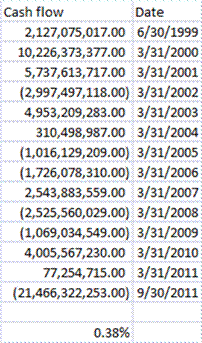The Best of the Aleph Blog, Part 15
This stretches from August 2010 to October 2010:
The Education of a Corporate Bond Manager, Part VII
On the value of credit analysts.
The Education of a Corporate Bond Manager, Part VIII
On price discovery in dealer markets, and auctions gone wrong.? I never knew that I could haggle so well.
The Education of a Corporate Bond Manager, Part IX
On the vagaries of bulge-bracket brokers, and how a good reputation helps on Wall Street.
The Education of a Corporate Bond Manager, Part X
On how we almost did a CDO, and how it fell apart.? Also, how to make money in the bond market when you reach the risk limits. 😉
The Education of a Corporate Bond Manager, Part XI
On my biggest mistakes in managing bonds.? Also, on aggressive life insurance managements.
The Education of a Corporate Bond Manager, Part XII (The End)
On bond technical analysis, and how to deal with a rapidly growing client.?? Also, the end of my time as a bond manager, and the parties that came as a result.?? Oh, and putting your subordinates first.
Queasing over Quantitative Easing
Queasing over Quantitative Easing, Redux
Queasing over Quantitative Easing, Part III
Queasing over Quantitative Easing, Part IV
Queasing over Quantitative Easing, Part V
Queasing over Quantitative Easing, Part VI
The problems with the Fed’s seemingly “free lunch”strategy.? Pushes up asset prices and commodity prices, benefiting the rich versus the poor.
The Economic Geography of Publicly-Traded Companies in the United States by Sector
The Economic Geography of Publicly-Traded Companies in the United States by Sector (II)
Shows what US states have diversified vs concentrated economies by sector, and what states dominate each sector.
Industries are under-analyzed, relative to the market on the whole, and relative to individual companies. Spend time trying to find good companies with strong balance sheets in industries with lousy pricing power, and cheap companies in good industries, where the trends are not fully discounted.
Purchase equities that are cheap relative to other names in the industry. Depending on the industry, this can mean low P/E, low P/B, low P/S, low P/CFO, low P/FCF, or low EV/EBITDA.
Stick with higher quality companies for a given industry.
Purchase companies appropriately sized to serve their market niches.
Analyze financial statements to avoid companies that misuse generally accepted accounting principles and overstate earnings.
Analyze the use of cash flow by management, to avoid companies that invest or buy back their stock when it dilutes value, and purchase those that enhance value through intelligent buybacks and investment.
Rebalance the portfolio whenever a stock gets more than 20% away from its target weight. Run a largely equal-weighted portfolio because it is genuinely difficult to tell what idea is the best. Keep about 30-40 names for diversification purposes.
Make changes to the portfolio 3-4 times per year. Evaluate the replacement candidates as a group against the current portfolio. New additions must be better than the median idea currently in the portfolio. Companies leaving the portfolio must be below the median idea currently in the portfolio.
The Portfolio Rules Work Together
How the portfolio rules work together to create a “margin of safety.”
When rules become known and acted upon, the system changes to incorporate them, making them temporarily useless, until they are forgotten again.
When a single strategy becomes dominant, it can become temporarily self-reinforcing.? Eventually, it will become self-reinforcing on the negative side.
A healthy market ecology has multiple strategies that are working in separate areas at the same time.
There is room for a new risk model based on the idea that risk is unique among individuals, and inversely related to the price paid for an asset.? If a risk control model has an asset becoming more risky when prices fall, it is wrong.
In the end, economic systems work, and judicial systems modify to accommodate that.? The only exception to that is when a culture is dying.
Illiquidity is an underrated risk.? Most financial company failures are due to illiquidity, which usually takes the form of too many illiquid assets and liquid liabilities.? Adding to the difficulty is that it is generally difficult to price illiquid assets, because they don?t trade often.
Of Investment Earnings Assumptions and Century Bonds
If we could turn back the clock 65 or so years and set up a more conservative method of accounting for pension liabilities, we would be much better off today.
This piece won a small prize, and in turn, I received three speaking engagements.
People care more about fairness than improving their own economic/social position.
Earnings Estimates as a Control Mechanism, Flawed as they are
Earnings Estimates as a Control Mechanism, Flawed as they are, Redux
Earnings estimates have their problems, but they exist to give us a flawed method of estimating the future performance of companies.
-==-=-=-=-=–=-=
That’s all for now.? Never thought I would do so many long series when I started blogging.




